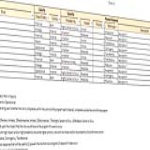Medical Risk Management Plan

I-Save, punan ang mga blanko, i-printa, Tapos na!
How to create a Medical Risk Management Plan? Download this Medical Risk Management Plan template now!
Mga magagamit na premium na format ng file:
.docx- Itong dokumento ay sertipikado ng isang Propesyonal
- 100% pwedeng i-customize
Business Negosyo management patient pasyente plan Organization Organisasyon Risk Program Programa Management Plan
How to create a Medical Risk Management Plan? An easy way to start completing your document is to download this example Medical Risk Management Plan template now!
We provide this Medical Risk Management Plan template to help professionalize the way you are working. Our business and legal templates are regularly screened and used by professionals. If time or quality is of the essence, this ready-made template can help you to save time and to focus on the topics that really matter!
Using this Medical Risk Management Plan template guarantees you will save time, cost and efforts! Completing documents has never been easier!
Download this Medical Risk Management Plan template now for your own benefit!
Risk management will influence, persuade and educate leaders within the following departments in order to achieve quality care in a safe environment and protect the organization s resources: Administration Allied Health and Adjunct Professional Services Billing Services Business Development and Marketing Clinical and Ancillary Services Data/Health Information and Privacy Management Employee Health Human Resources Infection Control Legal Services Medical Equipment Medical Staff (if applicable) Medical Staff Credentialing (if applicable) Patient Relations Quality/Performance Improvement Safety Management/Environment of Care Security Management Utilization Management Objectives of the Risk Management Program The objectives of the risk management program include, but are not limited to: promoting the quality of patient care, in collaboration with quality/performance improvement activities enhancing patient satisfaction minimizing the frequency and severity of adverse events supporting a non-punitive culture that promotes awareness and empowers staff to identify risk-related issues enhancing patient safety through participation in National Patient Safety Goals, organizational safety strategies and other patient safety initiatives enhancing environmental safety for patients, visitors and staff through participation in environment of care-related activities utilizing risk management strategies to identify and minimize the frequency and severity of near misses, incidents and claims managing adverse events and injuries to minimize financial loss evaluating systems that can contribute to patient care, error or injury educating stakeholders on emerging and known risk exposures and risk reduction initiatives achieving requirements promulgated by accrediting organizations complying with state-specific scope of practice, applicable laws, regulations and standards Specific Components The risk management program will include the following components: Event/Incident/Occurrence
DISCLAIMER
Wala sa 'site' na ito ang dapat ituring na legal na payo at walang abogado-kliyenteng relasyon na itinatag.
Mag-iwan ng tugon. Kung mayroon kang anumang mga katanungan o mga komento, maaari mong ilagay ang mga ito sa ibaba.

